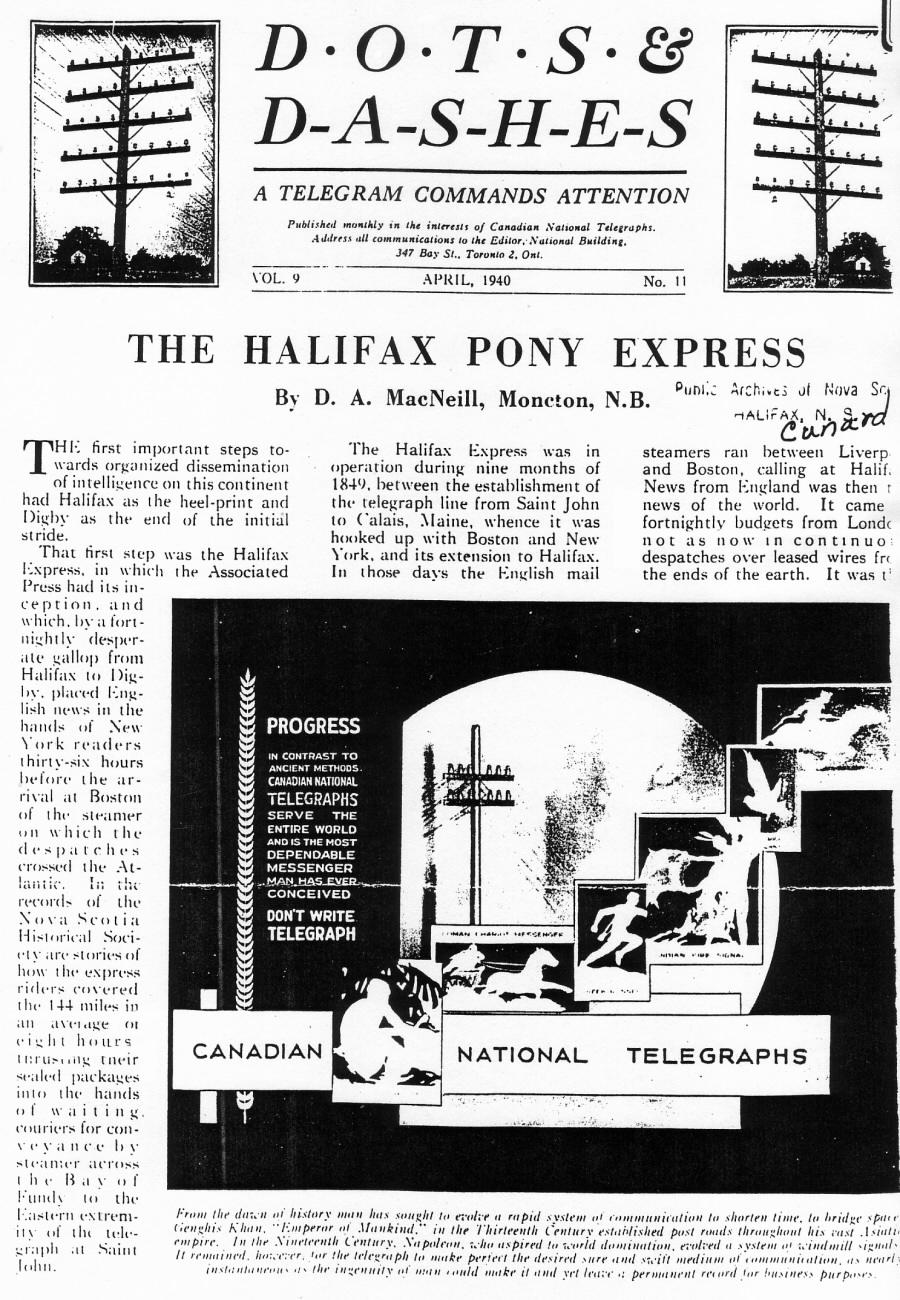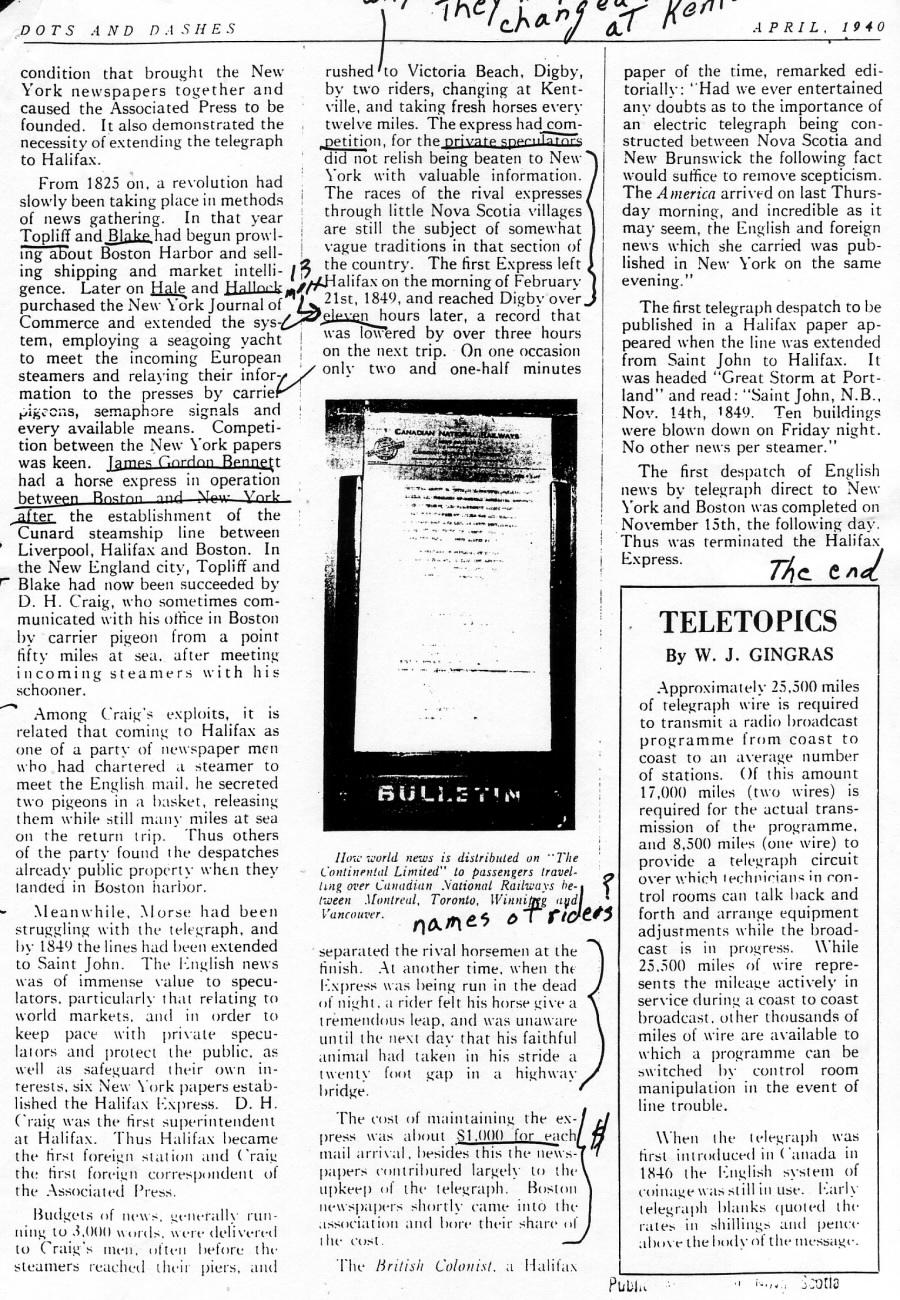Canadian National Telegraphs, owned by Canadian National Railway.

Dots & Dashes, April 1940 page 1 (above) page 2 (below)



Approximately 25,500 miles 41,100 kilometres of telegraph wire is required to transmit a radio broadcast programme from coast to coast to an average number of stations. Of this amount, 17,000 miles 27,400 kilometres (two wires) is required for the actual transmission of the programme, and 8,500 miles 13,700 kilometres (one wire) to provide a telegraph circuit over which technicians in control rooms can talk back and forth and arrange equipment adjustments while the broadcast is in progress. While 25,500 miles of wire represents the mileage actively in service during a coast to coast broadcast, other thousands of miles of wire are available to which a program can be switched by control room manipulation in the event of line trouble.
When the telegraph was first introduced in Canada in 1846 the English system of coinage was still in use. Early telegraph blanks quoted the rates in shillings and pence above the body of the message.
Not Digby!This article repeatedly refers to Digby as the Express destination: "...Digby as the end..." "...desperate gallop from Halifax to Digby..." "...rushed to Victoria Beach, Digby..." "The first Express...reached Digby..." Not the town of Digby, and not even Digby County. The destination was Victoria Beach, Annapolis County. Digby isn't even close. If a tourist family, today, should take directions from this article, and drive to Digby looking for the Pony Express Monument which marks the Express destination, they will find they are a good hour's drive from the true site. The mistake seems to arise from carelessness about names. The Express destination was Victoria Beach on Digby Gut. The chartered steamship lay at anchor in Digby Gut as it waited for the Horse Express to arrive. The transfer of the Associated Press news package, from the horse to the chartered steamship, occurred on the shore of Digby Gut. Digby Gut, yes. But not Digby. This seems to be one of those notorious historical mistakes that, once it has occurred, cannot ever be corrected. It just keeps on being copied from one writer to another, gaining new life with each repetition. In March 2002, the Halifax Regional Municipality website, in the section on the History of Halifax, at http://millennium.ns.sympatico.ca/index.html contains the following: "The bundle of news was dropped from the Cunard liner to a boat in the harbour, passed to a rider on the shore and rushed across the province to Digby." It isn't true! More than a year ago, I sent them an e-mail asking that they correct this mistake, but to this day there it is, part of the official history as published by the Halifax Regional Municipality. Apparently they just don't give a damn. |
...From 1825 on, a revolution had slowly been taking place in methods of news gathering. In that year Topliff and Blake had begun prowling about Boston Harbor and selling shipping and market intelligence...
[page 230] In the early years of the nineteenth century, Henry Ingraham Blake, of the Mercury and New England Palladium regularly boarded a small boat and rowed out to to collect the latest news from incoming ships in Boston harbor....James Gordon Bennett had a horse express in operation between Boston and New York after the establishment [in 1840] of the Cunard steamship line between Liverpool, Halifax, and Boston...
[page 30] James Gordon Bennett arranged horse expresses earlier than that, for the purpose of obtaining news quickly. In 1832, when Bennett was working as associate editor for the New York Courier and Enquirer, there was a change of management which redirected Bennett's energy more to news-gathering than to editorial work. He travelled as a correspondent, and organized a horse relay service "that brought the president's message from Washington to New York in fifteen hours."
More About the
|